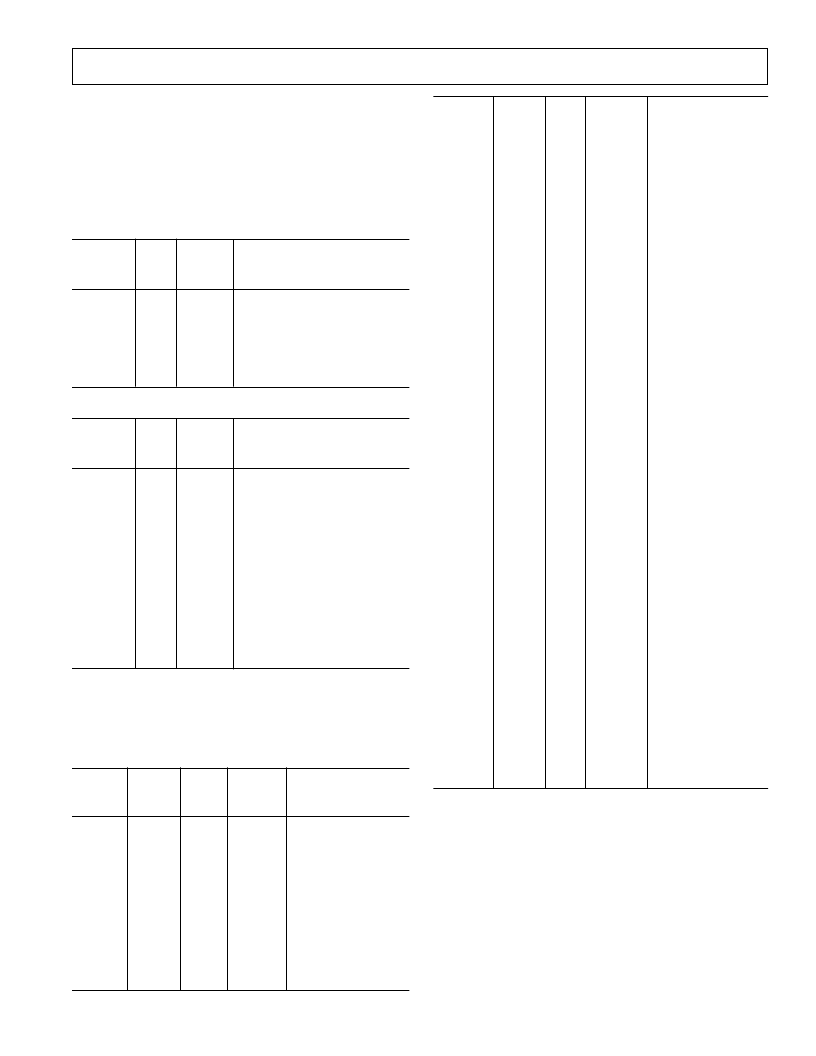- 您現(xiàn)在的位置:買賣IC網(wǎng) > PDF目錄374037 > ADSP-21XX1111 (Analog Devices, Inc.) ADSP-2100 Family DSP Microcomputers PDF資料下載
參數(shù)資料
| 型號: | ADSP-21XX1111 |
| 廠商: | Analog Devices, Inc. |
| 英文描述: | ADSP-2100 Family DSP Microcomputers |
| 中文描述: | 的ADSP - 2100系列DSP的微機 |
| 文件頁數(shù): | 5/32頁 |
| 文件大?。?/td> | 231K |
| 代理商: | ADSP-21XX1111 |
第1頁第2頁第3頁第4頁當前第5頁第6頁第7頁第8頁第9頁第10頁第11頁第12頁第13頁第14頁第15頁第16頁第17頁第18頁第19頁第20頁第21頁第22頁第23頁第24頁第25頁第26頁第27頁第28頁第29頁第30頁第31頁第32頁

ADSP-21mod870
–5–
REV. 0
Memory Interface Pins
The ADSP-21mod870 processor can be used in one of two
modes: Full Memory Mode, which allows BDMA operation
with full external overlay memory and I/O capability, or Host
Mode, which allows IDMA operation with limited external
addressing capabilities. The operating mode is determined by
the state of the Mode C pin during RESET and cannot be
changed while the processor is running.
Full Memory Mode Pins (Mode C = 0)
#
of
Pins
Input/
Output
Pin Name
Function
A13:0
14
O
Address Output Pins for Pro-
gram, Data, Byte and I/O Spaces
Data I/O Pins for Program,
Data, Byte and I/O Spaces
(8 MSBs Are Also Used as
Byte Memory Addresses)
D23:0
24
I/O
Host Mode Pins (Mode C = 1)
#
of
Pins
Input/
Output
Pin Name
Function
IAD15:0
A0
16
1
I/O
O
IDMA Port Address/Data Bus
Address Pin for External I/O,
Program, Data, or Byte Access
Data I/O Pins for Program,
Data Byte and I/O Spaces
IDMA Write Enable
IDMA Read Enable
IDMA Address Latch Pin
IDMA Select
IDMA Port Acknowledge
Configurable in Mode D; Open
Drain
D23:8
16
I/O
IWR
IRD
IAL
IS
IACK
1
1
1
1
1
I
I
I
I
O
In Host Mode, external peripheral addresses can be decoded using the A0,
CMS
,
PMS
,
DMS
and
IOMS
signals.
Terminating Unused Pin
The following table shows the recommendations for terminating
unused pins.
Pin Terminations
I/O
3-State
(Z)
Hi-Z*
Caused
By
Pin
Name
Reset
State
Unused
Configuration
XTAL
CLKOUT
A13:1 or
IAD12:0
A0
D23:8
D7 or
IWR
D6 or
IRD
D5 or
IAL
I
O
O (Z)
I/O (Z)
O (Z)
I/O (Z)
I/O (Z)
I
I/O (Z)
I
I/O (Z)
I
I
O
Hi-Z
Hi-Z
Hi-Z
Hi-Z
Hi-Z
I
Hi-Z
I
Hi-Z
I
Float
Float
Float
Float
Float
Float
Float
High (Inactive)
Float
High (Inactive)
Float
Low (Inactive)
BR
,
EBR
IS
BR
,
EBR
BR
,
EBR
BR
,
EBR
BR
,
EBR
BR
,
EBR
BR
,
EBR
D4 or
IS
D3 or
IACK
D2:0 or
IAD15:13
PMS
DMS
BMS
IOMS
CMS
RD
WR
BR
BG
BGH
IRQ2
/PF7
I/O (Z)
I
I/O (Z)
**
I/O (Z)
I/O (Z)
O (Z)
O (Z)
O (Z)
O (Z)
O (Z)
O (Z)
O (Z)
I
O (Z)
O (Z)
I/O (Z)
Hi-Z
I
Hi-Z
**
Hi-Z
Hi-Z
O
O
O
O
O
O
O
I
O
O
I
BR
,
EBR
Float
High (Inactive)
Float
Float
Float
Float
Float
Float
Float
Float
Float
Float
Float
High (Inactive)
Float
Float
Input = High (Inactive)
or Program as Output,
Set to 1, Let Float
Input = High (Inactive)
or Program as Output,
Set to 1, Let Float
Input = High (Inactive)
or Program as Output,
Set to 1, Let Float
Input = High (Inactive)
or Program as Output,
Set to 1, Let Float
Input = High or Low,
Output = Float
High or Low
High or Low
High or Low
Float
Input = High or Low,
Output = Float
High or Low
High or Low
High or Low
Float
BR
,
EBR
BR
,
EBR
IS
BR
,
EBR
BR
,
EBR
BR
,
EBR
BR
,
EBR
BR
,
EBR
BR
,
EBR
BR
,
EBR
EE
EE
IRQL1
/PF6
I/O (Z)
I
IRQL0
/PF5
I/O (Z)
I
IRQE
/PF4
I/O (Z)
I
SCLK0
I/O
I
RFS0
DR0
TFS0
DT0
SCLK1
I/O
I
I/O
O
I/O
I
I
O
O
I
RFS1/
IRQ0
DR1/
FI
TFS1/
IRQ1
DT1/
FO
EE
EBR
EBG
ERESET
EMS
EINT
ECLK
ELIN
ELOUT
I/O
I
I/O
O
I
I
O
I
O
I
I
I
O
I
I
O
O
I
I
O
I
O
I
I
I
O
NOTES
*
*Hi-Z = High Impedance.
**Determined by MODE D pin:
Mode D = 0 and in host mode:
IACK
is an active, driven signal and cannot
be “wire ORed.”
Mode D = 1 and in host mode:
IACK
is an open source and requires an
external pull-down, but multiple
IACK
pins can be “wire ORed” together.
1.If the CLKOUT pin is not used, turn it OFF.
2.If the Interrupt/Programmable Flag pins are not used, there are two options:
Option 1: When these pins are configured as INPUTS at reset and function
as interrupts and input flag pins, pull the pins High (inactive).
Option 2: Program the unused pins as OUTPUTS, set them to 1, and let
them float.
3.All bidirectional pins have three-stated outputs. When the pins is configured
as an output, the output is Hi-Z (high impedance).
4.CLKIN, RESET, and PF3:0 are not included in the table because these pins
must be used.
相關(guān)PDF資料 |
PDF描述 |
|---|---|
| ADSP-21XX4444 | ADSP-2100 Family DSP Microcomputers |
| ADSP-21MSP5859 | LM101A/LM201A/LM301A Operational Amplifiers; Package: MDIP; No of Pins: 8; Qty per Container: 40; Container: Rail |
| ADSP-21XX | ADSP-2100 Family DSP Microcomputers |
| ADSP-21MOD970-110 | Multiport Internet Gateway Processor Solution |
| ADSP-21mod970-110 | Data Pump Solution Gateway Processor Solution(多端口網(wǎng)關(guān)處理器解決方案) |
相關(guān)代理商/技術(shù)參數(shù) |
參數(shù)描述 |
|---|---|
| ADSP-3128AJG | 制造商:Rochester Electronics LLC 功能描述:- Bulk 制造商:Analog Devices 功能描述: |
| ADSP-3128ASG/883B | 制造商:Rochester Electronics LLC 功能描述:- Bulk |
| ADSP-3201JG | 制造商:Rochester Electronics LLC 功能描述:- Bulk 制造商:Analog Devices 功能描述: |
| ADSP-3201KG | 制造商:Rochester Electronics LLC 功能描述:- Bulk 制造商:Analog Devices 功能描述:MULTIPLIER, 144 Pin, Ceramic, PGA |
| ADSP-3201TG | 制造商:Rochester Electronics LLC 功能描述:- Bulk |
發(fā)布緊急采購,3分鐘左右您將得到回復。